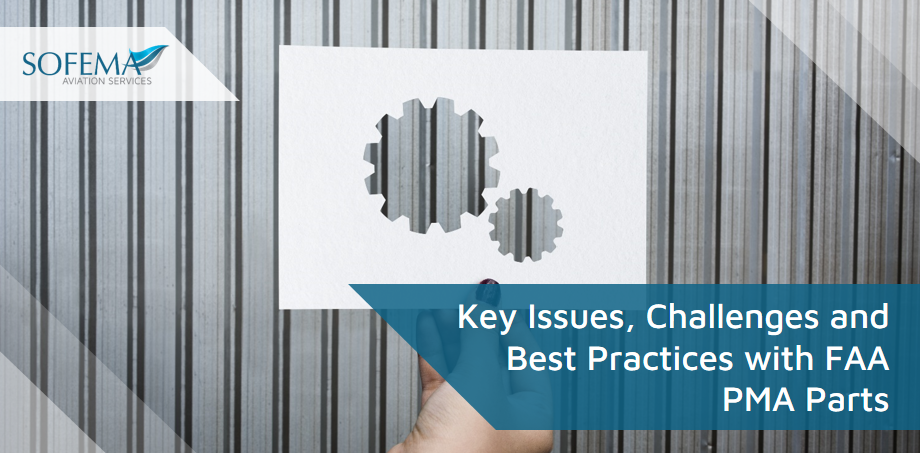Discussion Document Presented by Steve Bentley FRAeS CEO of Sofema (SAS) www.sassofia.com considering a number of key issues, challenges and best practices
Introduction
The FAA Parts Manufacturer Approval (PMA) is a combined design and production approval for modifying and producing replacement parts for aircraft.
- It allows manufacturers to create aftermarket parts that meet or exceed the performance and reliability of original equipment manufacturer (OEM) parts.
- The production and approval of FAA PMA parts offer manufacturers a lucrative opportunity to compete with OEMs in the aviation industry, but there are significant regulatory, legal, and market challenges.
- Best practices such as implementing strong quality systems, maintaining open communication with the FAA, extensive testing, and educating the market can help overcome these challenges and establish PMA parts as a viable alternative to OEM parts.
The process of producing FAA PMA parts comes with specific challenges, issues, and best practices.
Key Issues and Challenges with FAA PMA Parts
Regulatory Compliance and Approval Process:
- Complex Approval Process: Manufacturers must demonstrate that their parts meet the same safety and reliability standards as OEM parts.
- This requires thorough documentation, testing, and sometimes reverse engineering.
- Certification Barriers: Achieving PMA certification can be challenging due to the detailed FAA requirements.
- Risk of Non-Compliance: Failure to meet strict FAA requirements can lead to penalties, rework, or even revocation of PMA status.
Intellectual Property and Legal Issues:
- Reverse Engineering: Some PMA parts are reverse-engineered versions of OEM parts, which can create intellectual property (IP) conflicts. OEMs may claim that certain proprietary features have been copied without permission.
- Legal Disputes: The relationship between PMA part manufacturers and OEMs can be contentious, leading to legal challenges over patent infringement or misappropriation of proprietary designs.
Aviation Market Acceptance:
- OEM Influence: Some airlines or maintenance, repair, and overhaul (MRO) shops may be hesitant to use PMA parts due to concerns about quality, warranty conflicts, or pressure from OEMs to stick with original parts.
- Perception of Quality: Convincing the aviation industry of the quality and reliability of PMA parts can be difficult, particularly in the absence of long-term data or extensive use cases.
Supply Chain and Production Challenges:
- Production Consistency: Maintaining consistent quality across production batches is essential. PMA holders need robust quality control measures to ensure that every part meets the same stringent standards.
- Supplier Issues: PMA manufacturers often depend on suppliers for raw materials and components. Any disruptions or variations in supplier performance can affect part quality and lead to delays in production.
Testing and Engineering Requirements:
- Manufacturers need to provide evidence that their parts are as safe and reliable as OEM parts, which can require extensive testing, including stress analysis, fatigue testing, and performance evaluation.
- It can be challenging to have the required engineering resources and expertise to design and test PMA parts to FAA standards.
- Extensive testing, including life-cycle testing, failure analysis, and performance benchmarking against OEM parts, is critical.
- Ensuring that your parts can withstand the same operational conditions as OEM parts builds credibility and ensures regulatory compliance.
Best Practices for FAA PMA Parts Production
Strong Quality Management Systems (QMS):
- Implementing a robust QMS, such as ISO 9001 or AS9100, ensures that production processes, documentation, and quality control are maintained at a high standard.
- Close Collaboration with the FAA – Early and ongoing communication with the FAA throughout the design, testing, and certification process can help manufacturers identify and resolve potential issues before they become significant obstacles.
- Engaging with the FAA’s Aircraft Certification Office (ACO) can also smooth the certification process.
Clear Documentation and Traceability:
- Providing detailed documentation on part specifications, testing, and performance is essential for both regulatory approval and customer confidence.
- Documentation should also include traceability information for materials and production processes to ensure accountability and quality control.
Next Steps
Follow this link to our Library to find & download related documents for Free.
Sofema Aviation Services (SAS) and Sofema Online (SOL) provides regulatory training related to Bilateral relationships between EASA – FAA – TCAA and UK CAA please see the websites or email team@sassofia.com.
Tags:
Aircraft parts, OEM vs PMA, Testing Standards, Intellectual Property, Regulatory Challenges, Aviation Manufacturing, PMA Compliance, FAA PMA Parts, Aviation Supply Chain, aviation safety, Aviation Regulations, SAS blogs, Certification, Quality Management, FAA, EASA, Aviation Training




